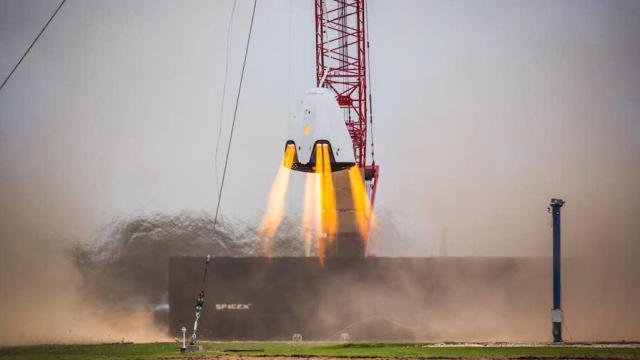Investigators looking into the cause of the SpaceX Crew Dragon explosion back in April are now blaming a faulty valve for the anomaly, which allowed leaking fuel to come into contact with titanium. Officials with SpaceX say they’ve already got a fix, but it’s still not clear when the company will be able to resume flight tests.
The incident happened on April 20, 2019 at Cape Canaveral Air Force Station in Florida, as SpaceX was conducting static fire tests of its Crew Dragon capsule. The Crew Dragon used in the test was the same one used for the Demo-1 mission, which saw an uncrewed capsule visit the International Space Station back in March. SpaceX, in collaboration with NASA, is currently working toward an in-flight abort test of the vehicle and the much-anticipated Demo-2 mission, which will involve a crew of two NASA astronauts, Douglas Hurley and Robert Behnken. NASA, with the help of private partners, is striving to restore the United States’ ability to send astronauts to space, which it hasn’t been able to do independently since the retirement of the Space Shuttle Program in 2011.
On the day of the accident, SpaceX managed to perform successful tests of the smaller, manoeuvring Draco thrusters. It’s when the attention shifted to the eight SuperDraco thrusters, used in the abort system, that things went very wrong. Just moments before the SuperDracos were ignited, an anomaly caused an explosion, resulting in the destruction of the capsule. Thankfully, no one was injured.
Following the incident, SpaceX launched an investigation that involved NASA, the Federal Aviation Administration (FAA), and the National Transportation Safety Board (NTSB). The investigation is still ongoing, but a SpaceX press release issued yesterday attributed the anomaly to a faulty valve.
The problem happened around 100 milliseconds prior to the firing of the eight SuperDraco engines, and while the system’s propulsion systems were being pressurised. The accident investigators said they found evidence of a leaking component that allowed nitrogen tetroxide (NTO) — a liquid oxidizer — to enter high-pressure helium tubes prior to ignition.
“A slug of this NTO was driven through a helium check valve at high speed during rapid initialization of the launch escape system, resulting in structural failure within the check valve,” said SpaceX in its press release. “The failure of the titanium component in a high-pressure NTO environment was sufficient to cause ignition of the check valve and led to an explosion.”
SpaceX said the reaction between titanium and nitrogen tetroxide at high pressure “was not expected.”
Speaking to reporters yesterday, as reported by SpaceNews, Hans Koenigsmann, the vice president of build and flight reliability at SpaceX, described the glitch like this: “When you [push] the slug [of NTO] into the check valve, it basically creates an explosion.” Koenigsmann said this scenario was demonstrated in subsequent tests, adding that, “when the pressure is pretty high, the temperature is high, and you drive a slug with a lot of energy into a titanium component, you can have these rather violent reactions.”
SpaceX is now reconfiguring the system to prevent the leak from happening again. Thankfully, the remedy won’t require a major overhaul of the CrewDragon concept. Basically, SpaceX engineers need to eliminate the flow path within the launch system such that the liquid propellant cannot leak into the gaseous pressurisation system.
To do this, they’re going to replace the check valves, which are unidirectional, with a device known as a burst disk, also known as a rupture disk. These single-use devices are designed to create a complete seal until they’re opened by high pressure. SpaceX said the bursts disks will “mitigate the risk entirely,” with Koenigsmann saying, “I feel like this is actually the better component [for the escape system].”
During yesterday’s press conference, NASA’s Kathy Lueders, manager of the agency’s Commercial Crew Program, referred to the incident as a “huge gift.” Indeed, better to find the problem now than during a crewed mission. Needless to say, this is exactly why static tests are conducted.
Koenigsmann said the investigation is now 80 per cent complete, but the changes to and testing of the Crew Dragon are already underway. The required modifications, he said, can happen in parallel with other scheduled work on the system. The SpaceX and NASA officials were reluctant to provide timelines for the inflight abort test and the Demo-2 mission, but Koenigsmann conceded that it’s becoming “increasingly difficult” to stay on a schedule that would see a crewed mission happening later this year.
“We’re going to fly when we feel like the certification work has been done to be able to safely fly our crews,” added Leuders. “I hope it’s this year, but we’re going to fly when it’s the right time and when we know we’ll be flying our crews safely.”
